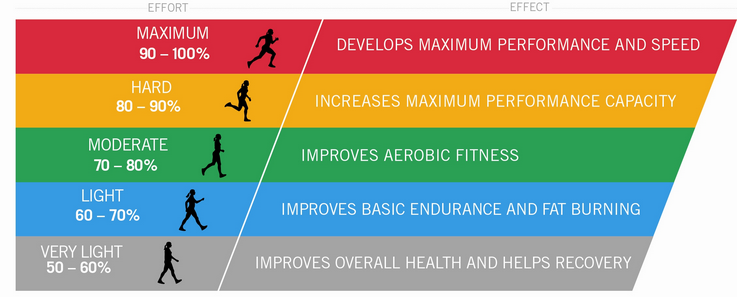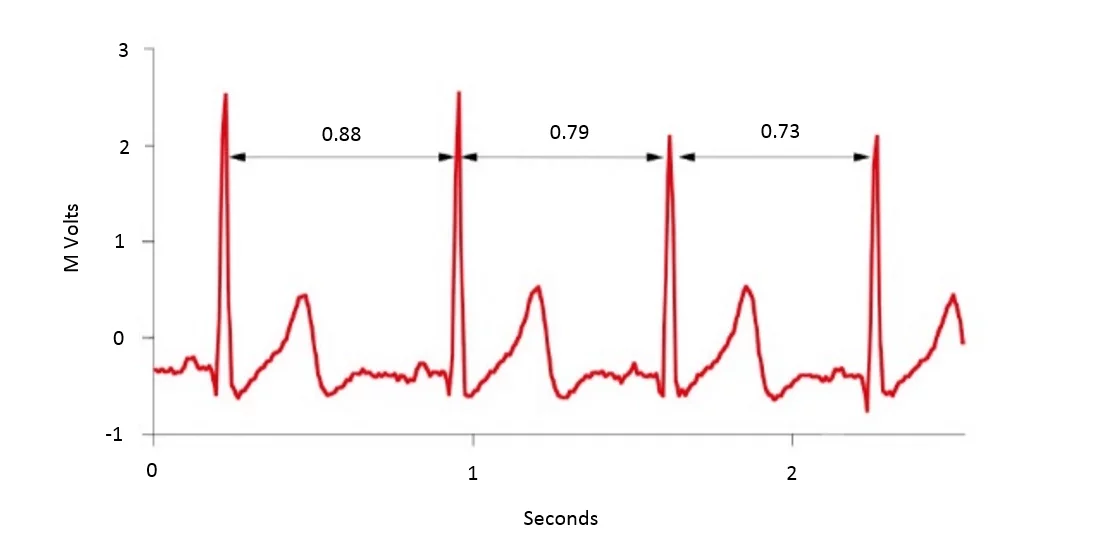Optimising CV Training with the Five Heart Rate Zone Model

When it comes to enhancing cardiovascular fitness, understanding and utilising heart rate zones can be a game-changer. The five-zone heart rate model offers a structured approach to tailoring workouts based on intensity, ultimately helping individuals reach their fitness goals more effectively. This detailed guide delves into the science behind the five heart rate zones, how to leverage them for aerobic training, and the importance of accurately determining your maximum heart rate (MHR) for precise training.
The Five Heart Rate Zones Explained
Heart rate zones are defined as specific ranges of exercise intensity, each with distinct physiological benefits. These zones are generally expressed as a percentage of an individual’s maximum heart rate (MHR). The five-zone model includes:
-
Zone 1: Very Light (50-60% MHR)
- Purpose: Recovery and warm-up
- Duration: 10-15 minutes
- Intensity: Minimal effort; comfortable and easy
- Benefits: Enhances blood circulation and aids in muscle recovery. Ideal for warming up before or cooling down after more intense exercise.
-
Zone 2: Light (60-70% MHR)
- Purpose: Fat burning and aerobic base building
- Duration: 30-60 minutes, 3-5 times per week
- Intensity: Moderate; conversation is possible but requires some effort
- Benefits: Improves aerobic capacity and facilitates fat oxidation. Effective for long-duration sessions aimed at building endurance.
-
Zone 3: Moderate (70-80% MHR)
- Purpose: Cardiovascular fitness and performance enhancement
- Duration: 20-40 minutes, 2-3 times per week
- Intensity: Challenging; conversation is difficult
- Benefits: Boosts cardiovascular efficiency and stamina. Enhances the body's ability to use oxygen efficiently.
-
Zone 4: Hard (80-90% MHR)
- Purpose: Lactate threshold improvement and strength development
- Duration: 15-30 minutes, 1-2 times per week
- Intensity: Very challenging; conversation is nearly impossible
- Benefits: Increases lactate threshold, allowing higher intensity efforts with reduced fatigue. Builds cardiovascular strength.
-
Zone 5: Maximum (90-100% MHR)
- Purpose: Peak performance and power
- Duration: 5-10 minutes of intervals, 1-2 times per week
- Intensity: Maximum effort; cannot be sustained for long
- Benefits: Develops speed, power, and anaerobic capacity. Useful for high-intensity interval training (HIIT) and sprinting.
The Importance of Accurate Maximum Heart Rate Determination
To maximise the effectiveness of heart rate zone training, accurately determining your MHR is crucial. While many training plans use estimated formulas, such as "220 minus age," or the Karvonen formula. these can be imprecise and may not reflect individual variations in heart rate response.
The Karvonen Formula is a method used to calculate target heart rates based on both your MHR and resting heart rate (RHR). It provides a more personalised target heart rate range than the simple "220 minus age" formula.
However, research indicates that these estimations can lead to inaccuracies, making direct measurement of MHR through a maximal exercise test a more reliable method.
Advantages of Direct MHR Measurement
Direct measurement of MHR involves performing a maximal exercise test, typically conducted under controlled conditions in a laboratory or clinical setting. This method offers several advantages:
- Precision: Provides a precise MHR that accounts for individual physiological variations.
- Personalisation: Reflects your specific cardiovascular fitness level, leading to more effective and tailored training plans (Wilmore & Costill, 2004).
Utilising Heart Rate Training Zones
Heart rate zone training allows for a structured approach to cardiovascular exercise, tailored to specific fitness goals. Below is a breakdown of how to effectively utilise each zone for aerobic training, including duration, intensity, and the percentage of MHR:
-
Zone 1: Recovery and Warm-Up
- Intensity: 50-60% MHR
- Duration: 10-15 minutes
- Purpose: Ideal for warming up before more intense exercise or cooling down afterwards. Enhances recovery and circulation.
- Scientific Insight: Low-intensity exercise in Zone 1 aids in muscle recovery and reduces soreness by promoting blood flow and metabolic waste removal (Gordon et al., 2012).
-
Zone 2: Endurance and Fat Burning
- Intensity: 60-70% MHR
- Duration: 30-60 minutes, 3-5 times per week
- Purpose: Builds aerobic capacity and burns fat. Effective for long-duration sessions aimed at improving endurance.
- Scientific Insight: Sustained exercise in Zone 2 optimises fat oxidation and enhances cardiovascular endurance (Coyle et al., 1997).
-
Zone 3: Aerobic Fitness and Performance
- Intensity: 70-80% MHR
- Duration: 20-40 minutes, 2-3 times per week
- Purpose: Improves cardiovascular efficiency and stamina. Beneficial for increasing VO2 max and overall aerobic performance.
- Scientific Insight: Training in this zone improves VO2 max and cardiovascular fitness, contributing to better overall performance (Hickson et al., 1988).
-
Zone 4: Lactate Threshold and Strength
- Intensity: 80-90% MHR
- Duration: 15-30 minutes, 1-2 times per week
- Purpose: Enhances lactate threshold, enabling higher intensity efforts with reduced fatigue. Builds cardiovascular strength and endurance.
- Scientific Insight: High-intensity intervals in Zone 4 are effective for increasing lactate threshold and improving cardiovascular strength (Gibala et al., 2006).
-
Zone 5: Speed and Power
- Intensity: 90-100% MHR
- Duration: 5-10 minutes of intervals, 1-2 times per week
- Purpose: Develops speed, power, and anaerobic capacity. Involves short, intense efforts followed by adequate recovery.
- Scientific Insight: Training in Zone 5 enhances anaerobic capacity and maximal power output, leading to improved speed and explosive performance (Chtara et al., 2005).
Implementing Heart Rate Zone Training
To make the most of heart rate zone training:
- Determine Accurate MHR: Opt for a maximal exercise test to accurately determine your MHR for precise zone calculations.
- Set Specific Goals: Tailor your training based on goals, such as improving endurance, increasing speed, or building strength.
- Monitor Your Heart Rate: Use a heart rate monitor to ensure you’re training within the correct zones.
- Incorporate Variety: Balance your training across different zones to optimise cardiovascular fitness and avoid plateaus.
- Allow Recovery: Ensure adequate recovery, particularly after high-intensity sessions, to prevent overtraining and support performance gains.
Conclusion
Heart rate zone training offers a scientifically grounded approach to enhancing aerobic conditioning. By accurately determining your MHR and training within the appropriate zones, you can tailor your workouts to achieve specific fitness goals. Whether aiming to improve endurance, speed, or overall cardiovascular strength, the five-zone model provides a structured framework for optimising your aerobic training.
References
- Chtara, M., Chaouachi, A., Levy, R., & Chtara, H. (2005). Effect of training on aerobic and anaerobic capacities in well-trained rowers. Journal of Sports Sciences, 23(6), 601–608.
- Coyle, E. F., Jeukendrup, A. E., Oseto, M., & Holmes, B. (1997). Physiological demands of a 5-km race. Journal of Applied Physiology, 82(6), 1517–1523.
- Fujita, K., & Roberts, M. J. (2015). The role of small steps in achieving lasting weight loss. Behaviour Research and Therapy, 51(9), 687–694.
- Gibala, M. J., Little, J. P., MacDonald, M. J., & Hawley, J. A. (2006). Physiological adaptations to low-volume, high-intensity interval training in health and disease. Journal of Applied Physiology, 100(1), 286–295.
- Gordon, B., Olds, T., & Lafferty, D. (2012). The benefits of low-intensity exercise on recovery. Journal of Sports Medicine, 32(8), 1001–1010.
- Hickson, R. C., Balke, B., & Coyle, E. F. (1988). Increased maximal oxygen uptake following short-term high-intensity interval training. Medicine & Science in Sports & Exercise, 20(3), 267–272.
- Wilmore, J. H., & Costill, D. L. (2004). Physiology of Sport and Exercise. Human Kinetics.






